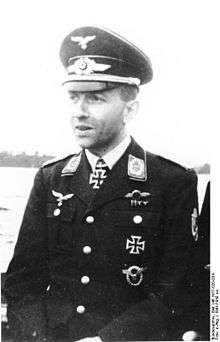Viktor von Loßberg
| Viktor von Loßberg | |
|---|---|
 | |
| Born |
14 March 1904 Posen |
| Died |
24 May 1983 (aged 79) Garmisch |
| Allegiance |
|
| Service/branch |
|
| Years of service | 1933–1945, 1956–1962 |
| Rank | Oberst im Generalstab |
| Unit | Kampfgeschwader 26 |
| Battles/wars | World War II |
| Awards | Knight's Cross of the Iron Cross |
Viktor von Loßberg[Note 1] (14 March 1904 – 24 May 1983) was a highly decorated Oberleutnant in the Luftwaffe during World War II, and a recipient of the Knight's Cross of the Iron Cross. The Knight's Cross of the Iron Cross was awarded to recognise extreme battlefield bravery or successful military leadership. Von Loßberg was instrumental in conceiving the concept of Zahme Sau (Tame Boar), a night fighter tactic.
Career
Von Loßberg was born on 14 March 1904 in Posen, present-day Poznań in Poland, at the time in the Province of Posen, a province of the Kingdom of Prussia in the German Empire. He joined the military service of the Wehrmacht in late 1933 at Braunschweig. The Treaty of Versailles signed after World War I had prohibited Germany from having an air force. Before the Luftwaffe was unveiled in 1935 he was trained as a pilot at civilian flight schools.[1]
Von Loßberg was involved in the testing and evaluation of various aircraft for use in the night fighter role. Generalfeldmarschall Erhard Milch favored the conversion of already existing variants such as the Junkers Ju 88 or its successor the Junkers Ju 188 because it did not influence production numbers. Josef Kammhuber on the other hand preferred the then new Heinkel He 219. The Reichsluftfahrtministerium (RLM—Reich Air Ministry) ordered a comparison test which was held on 25–26 March 1943 at Rechlin. Von Loßberg was ordered to fly the Ju 188 E-1 in mock combat against the He 219 piloted by Werner Streib. The test proved the He 219 to be superior to the Ju 188.[2]
He played a significant role in the development and introduction of the Zahme Sau night fighter system in mid-1943. This system proved itself to be more scalable to the increasing attacks by the Royal Air Force Bomber Command and eventually replaced the Himmelbett (canopy bed) of the Kammhuber Line. In the introductory phase of Zahme Sau, Von Loßberg flew 39 night fighter missions from airfields operated by I./Nachtjagdgeschwader 1. In total he flew 39 missions without claiming any victories himself.[1]
Awards
- Iron Cross (1939)
- Knight's Cross of the Iron Cross on 17 October 1941 as Major and Gruppenkommandeur of the III./Kampfgeschwader 26[4][5]
Notes
References
Citations
Bibliography
- Fellgiebel, Walther-Peer (2000) [1986]. Die Träger des Ritterkreuzes des Eisernen Kreuzes 1939–1945 — Die Inhaber der höchsten Auszeichnung des Zweiten Weltkrieges aller Wehrmachtteile [The Bearers of the Knight's Cross of the Iron Cross 1939–1945 — The Owners of the Highest Award of the Second World War of all Wehrmacht Branches] (in German). Friedberg, Germany: Podzun-Pallas. ISBN 978-3-7909-0284-6.
- Kaiser, Jochen (2011). Die Ritterkreuzträger der Kampfflieger—Band 2 [The Knight's Cross Bearers of the Bomber Flyer—Volume 2] (in German and English). Bad Zwischenahn, Germany: Luftfahrtverlag-Start. ISBN 978-3-941437-09-8.
- Remp, Roland (2000). Der Nachtjäger Heinkel He 219 [The Night Fighter Heinkel He 219] (in German). Oberhaching, Germany: AVIATIC Verlag GmbH. ISBN 978-3-925505-51-5.
- Scherzer, Veit (2007). Die Ritterkreuzträger 1939–1945 Die Inhaber des Ritterkreuzes des Eisernen Kreuzes 1939 von Heer, Luftwaffe, Kriegsmarine, Waffen-SS, Volkssturm sowie mit Deutschland verbündeter Streitkräfte nach den Unterlagen des Bundesarchives [The Knight's Cross Bearers 1939–1945 The Holders of the Knight's Cross of the Iron Cross 1939 by Army, Air Force, Navy, Waffen-SS, Volkssturm and Allied Forces with Germany According to the Documents of the Federal Archives] (in German). Jena, Germany: Scherzers Militaer-Verlag. ISBN 978-3-938845-17-2.